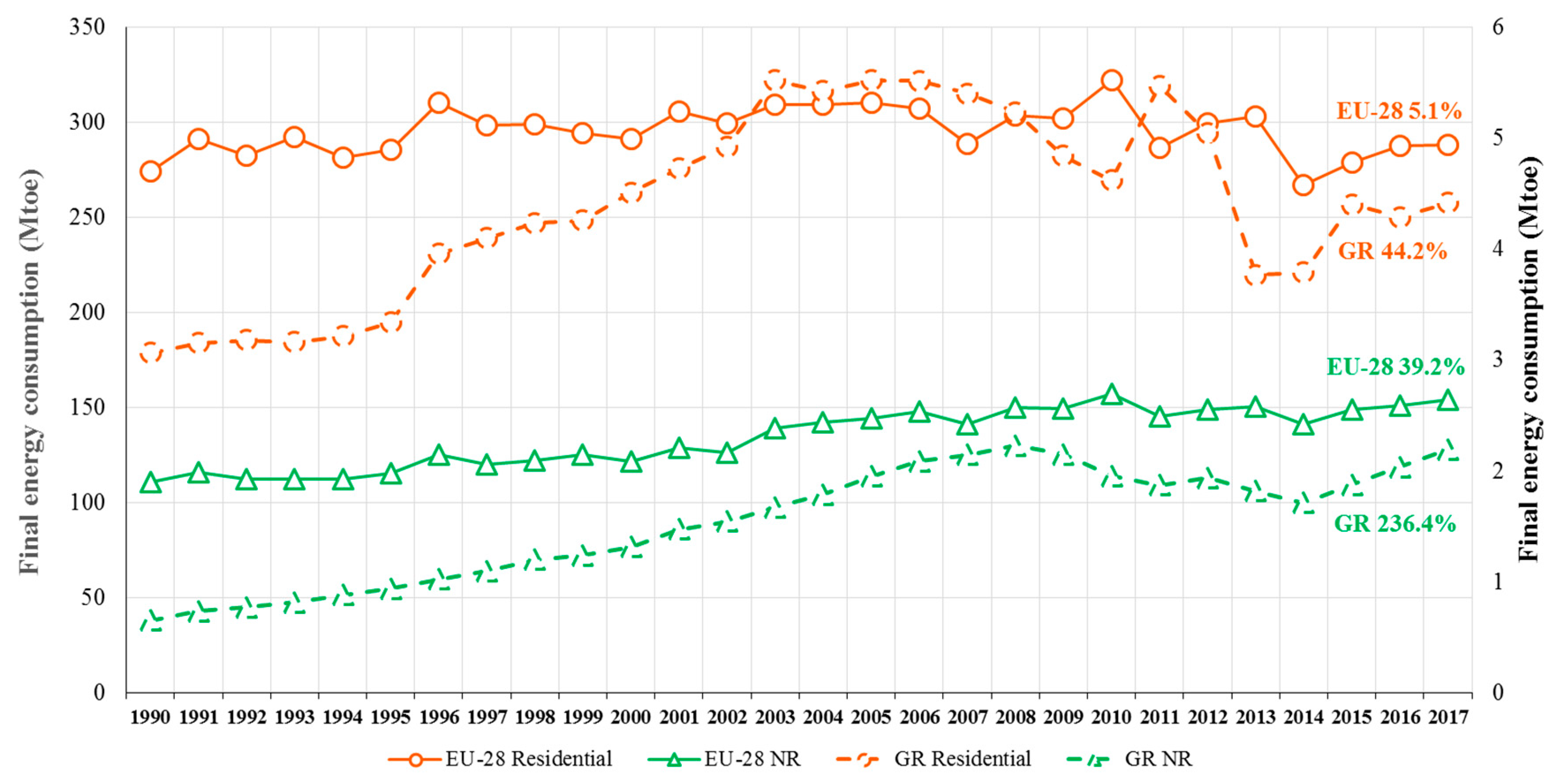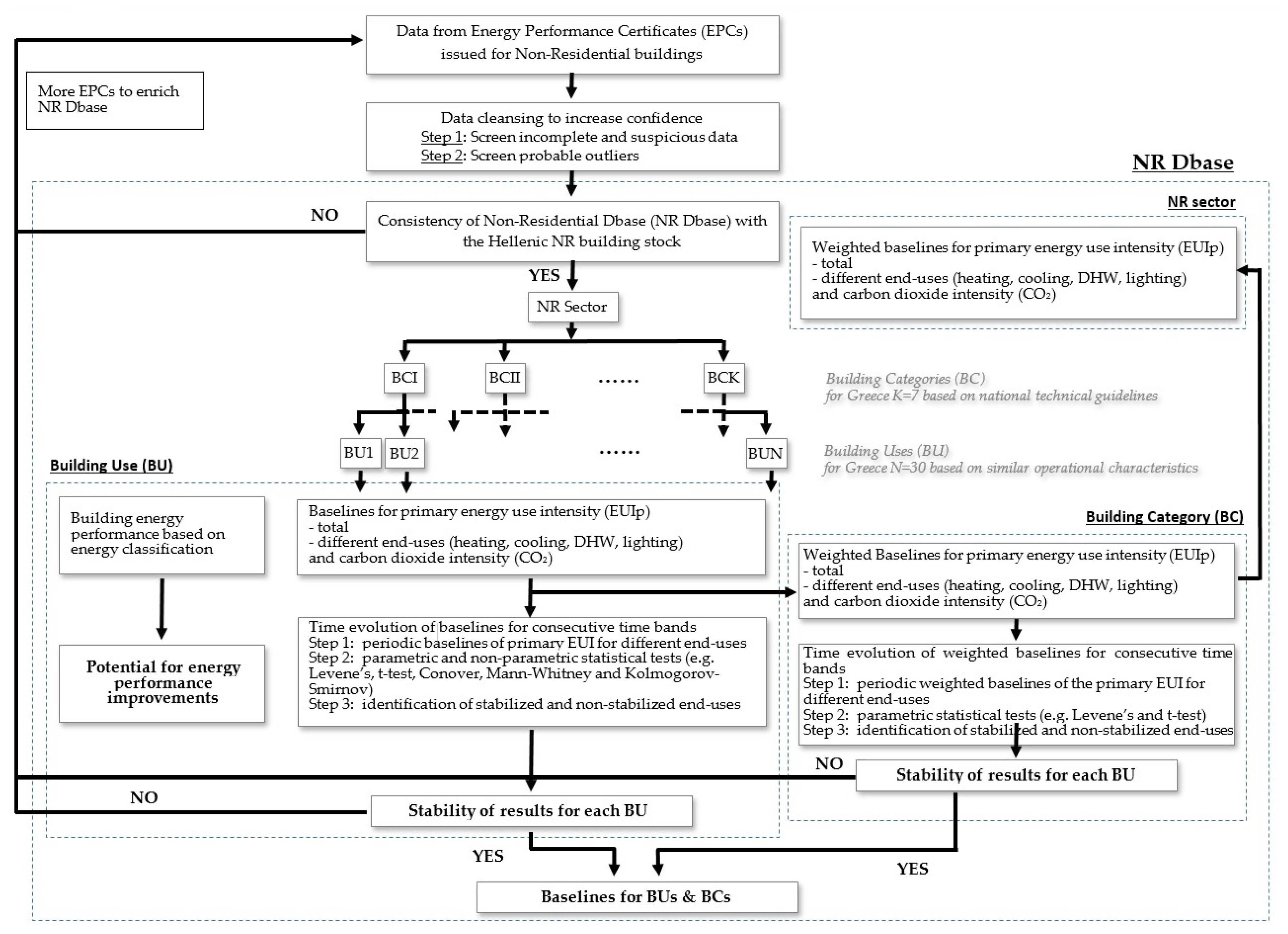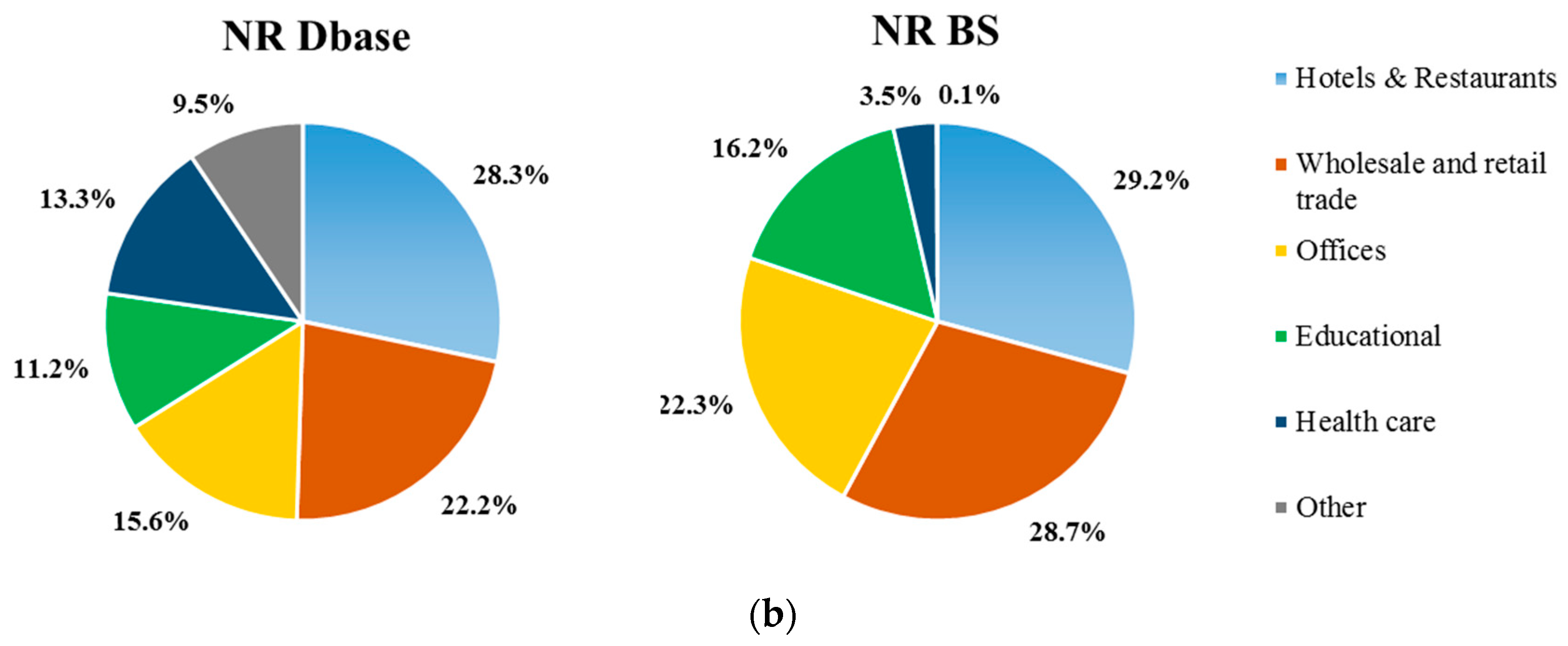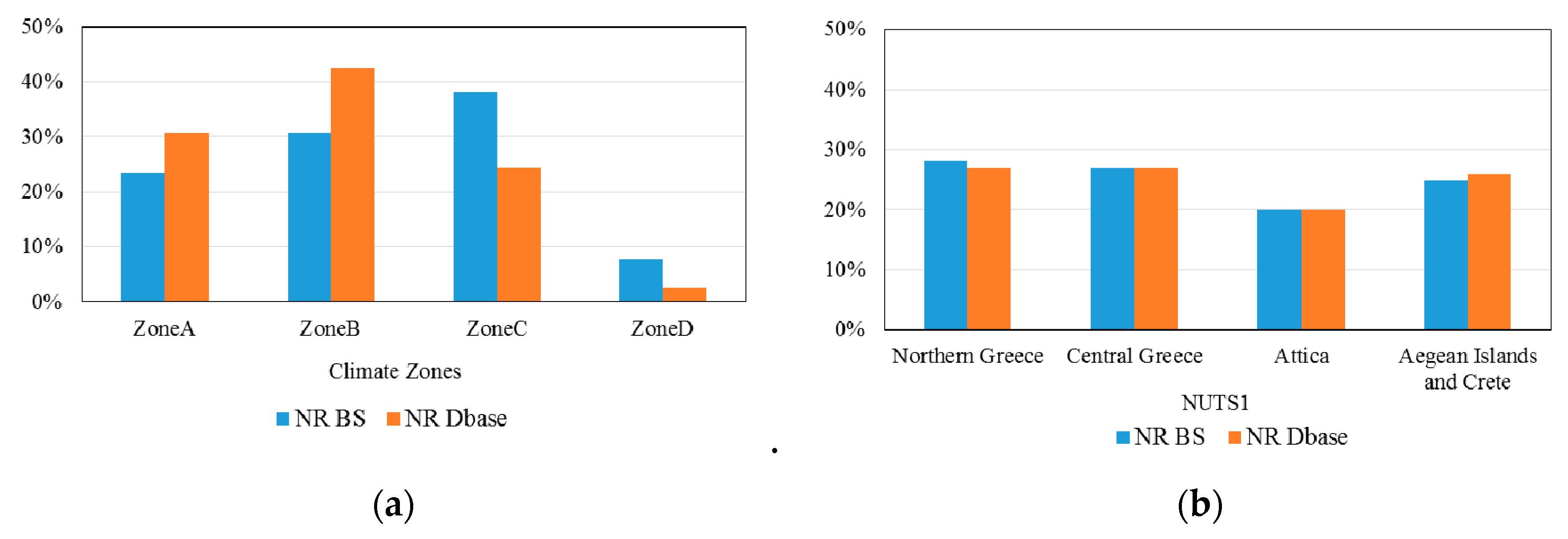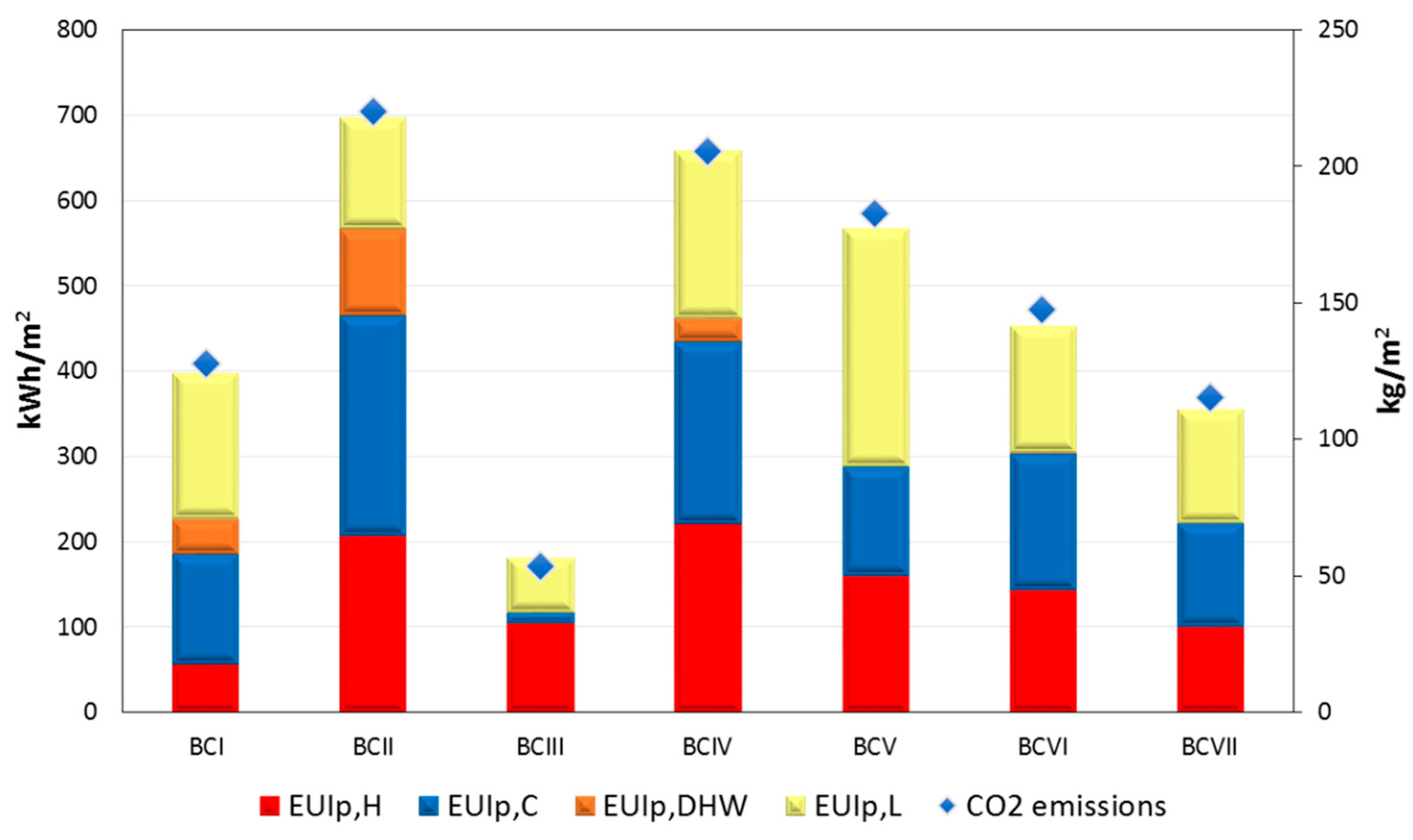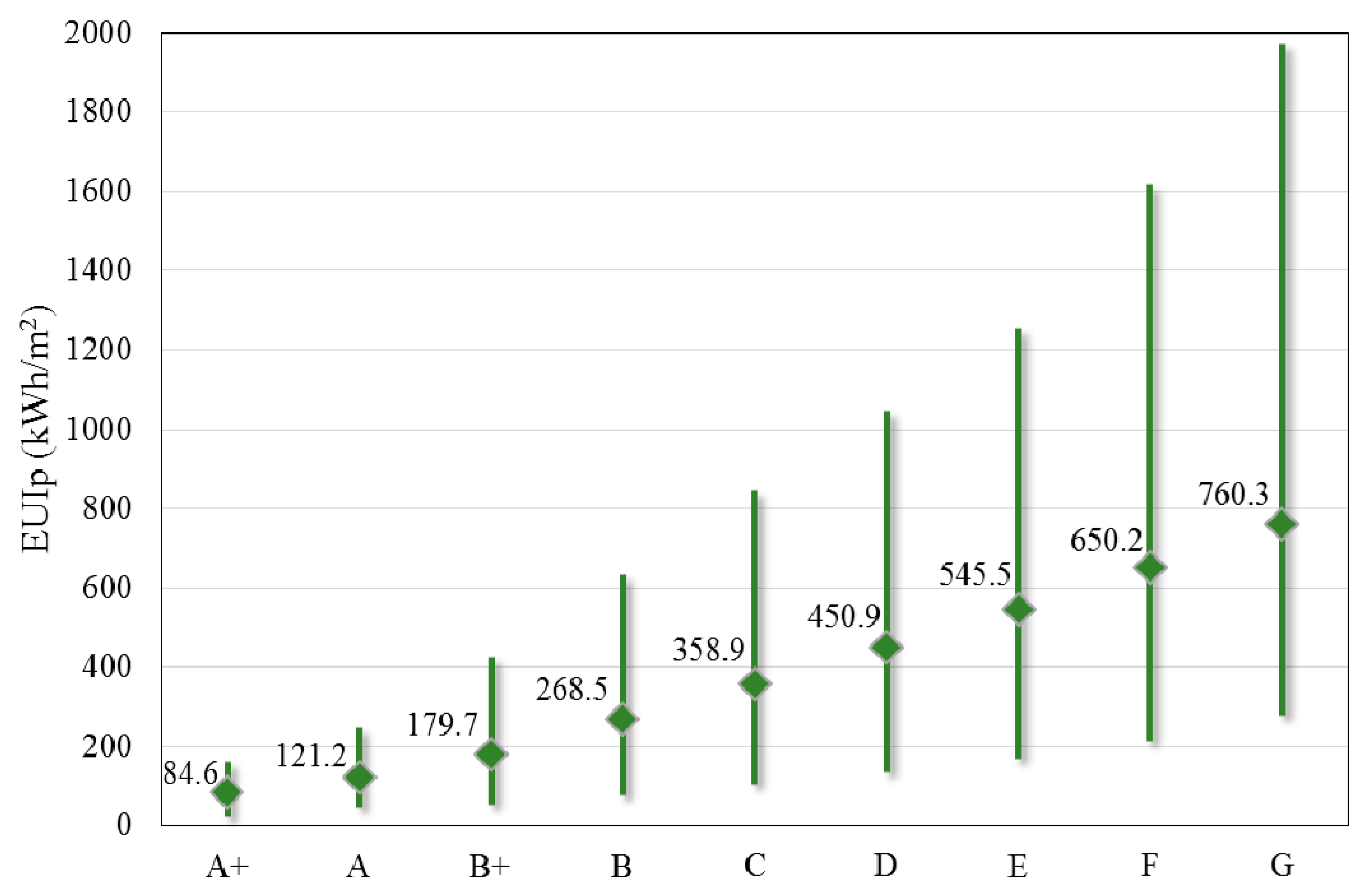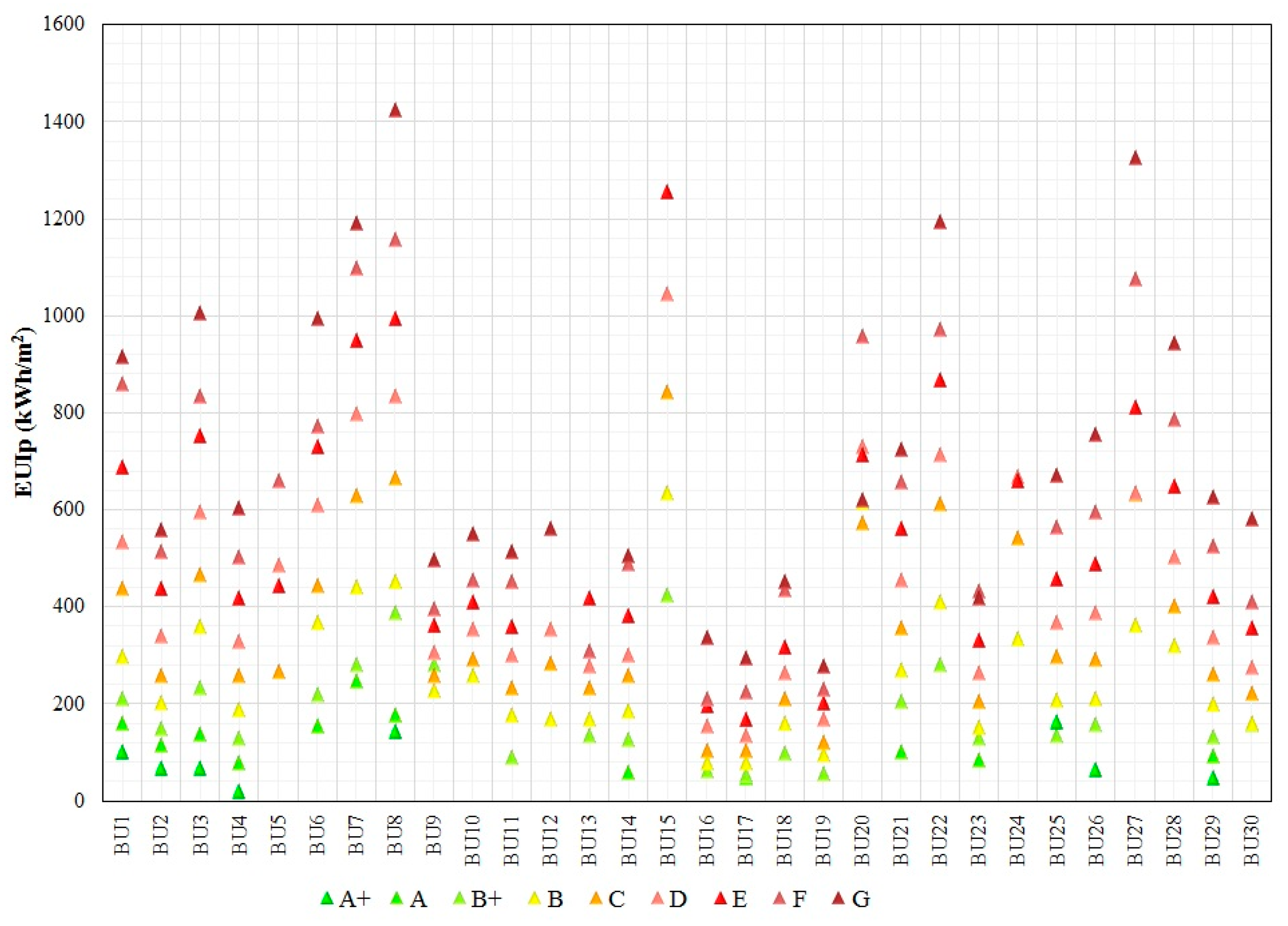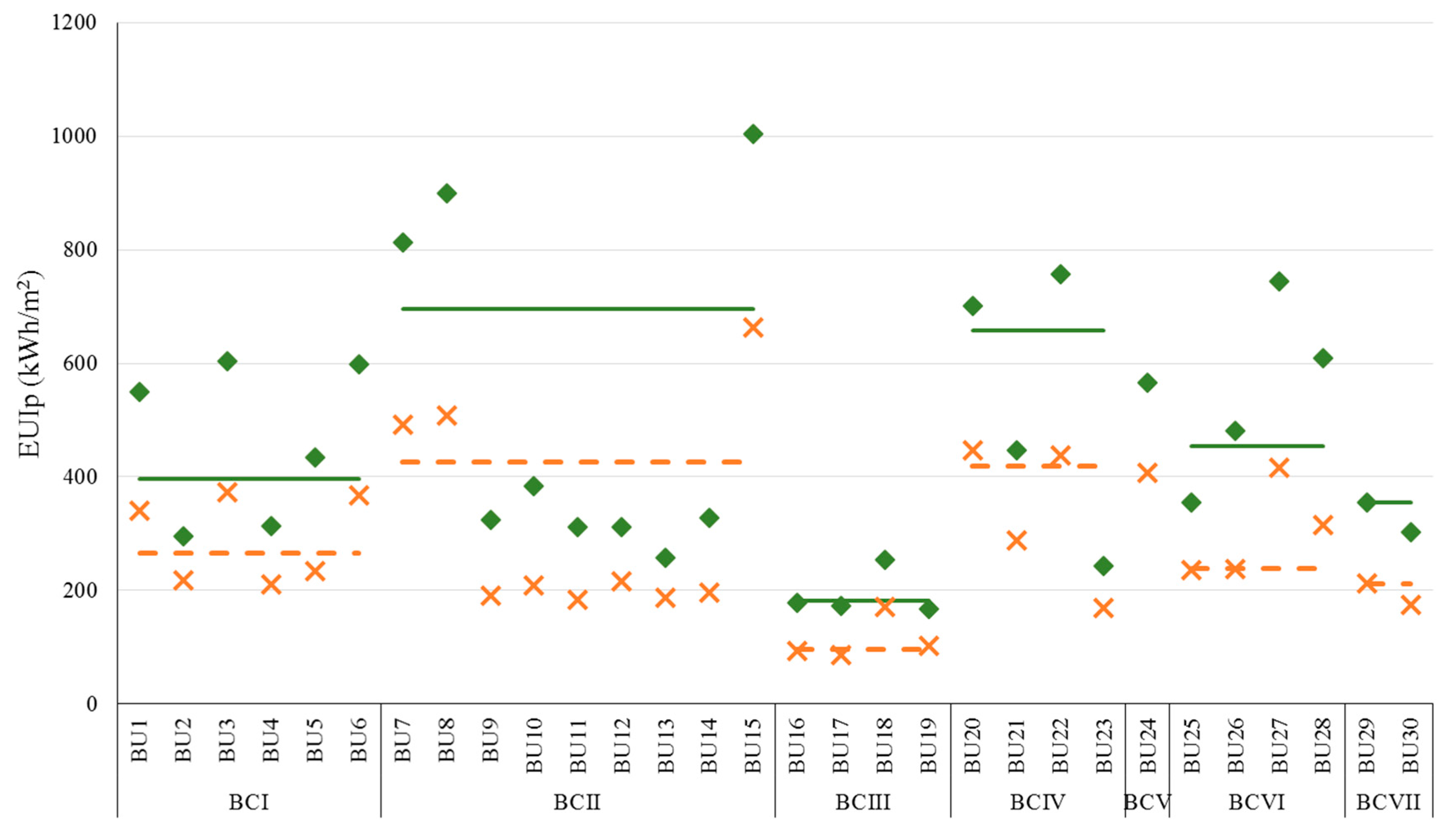1. Introduction
Built environment is a key target in European (EU) policies in order to achieve a sustainable and competitive low-carbon economy. EU buildings account for nearly 40% of energy consumption and 36% of CO
2 emissions [
1], despite covering only 3.35% of the total land area [
2]. About 35% of the building stock is old (over 50 years) and energy inefficient, while the annual renovation rate ranges between 0.4% and 1.2% depending on the country. Therefore, increased renovation of existing buildings may lead to significant savings both in total energy consumption and CO
2 emissions by about 5% [
1].
Nonresidential (NR) buildings, accounting for about a quarter of the total EU building stock, comprise a very heterogeneous sector with various building types, different building sizes and energy characteristics. Limited information is available on construction characteristics, installed systems for different services and energy use for the entire NR sector as well as for the various types and branches of activity.
Over the past decades, the total final energy consumption in the EU Member States (EU-28) has remained practically stable, rising only from 1033.4 million tonnes of oil equivalent (Mtoe) in 1990 to 1060.0 Mtoe in 2017 [
3]. However, the final energy consumption in NR buildings has boomed by 39.2%, from 110.7 Mtoe in 1990 to 154.0 Mtoe in 2017, keeping a relative stable share ranging from 11% to 15% of the total. The highest share in NR building’s sector final energy consumption is electricity with 50.14%, followed by gas with 30.12% [
4]. For 2050, the projection is that the NR buildings’ sector will account for about 17% of the total final energy use [
5].
1.1. Hellenic Nonresidential Buildings
Based on the most recent building census, the Hellenic Nonresidential Building Stock (NR BS) includes about 690,000 exclusive-use buildings (excluding churches, monasteries, industrial buildings and parking stations), representing 21% of the national building stock, with the majority being wholesale/retail trade and offices [
6]. The estimated total floor area is about 73.52 Mm
2, with the majority being hotels and restaurants [
3], while the total final energy in 2017 reached 16.05 Mtoe increased by 15.6% compared to 1990. NR buildings consumed 2.19 Mtoe in 2017, showing an increase by 236.4% since 1990 (
Figure 1). Although until 2008 the NR sector’s final consumption was steadily increasing by an average of 7% per year, it was one of the first sectors that was affected by the economic recession. This is reflected by the decrease of final energy consumption since 2009, with the exception of 2012, where a slight increase occurred due to an increase of electricity consumption. From 2015, there was again a clear upward trend. Detailed information for the different NR building types is limited to only to a few studies [
7,
8].
To boost energy performance of buildings, the EU has established an ambitious legislative framework that includes the Directive on Energy Efficiency (EED) recently revised by the Directive (EU) 2018/2002 amending Directive 2012/27/EU on energy efficiency, setting an EU target for energy consumption at less than 1273 Mtoe of primary energy and/or 956 Mtoe of final energy [
9]. Another main instrument for addressing these challenges is the Energy Performance of Buildings Directive (EPBD) recently amended by the Directive 2018/844, promoting cost-effective building renovations, with the vision of a decarbonized building stock by 2050 [
10]. Both directives are part of the new energy rulebook
Clean Energy for All Europeans [
11], according to which each Member State should draft an integrated 10-year national energy and climate plan (NECPs) for the time period 2021 to 2030.
Building energy certification plays a central role in the enhancement of the energy performance of buildings. The energy performance certificate (EPC) is a core instrument of the EPBD for existing and new buildings. The general idea behind the EPC is to influence the building market, by providing information on a building’s energy use and typical energy costs and by making recommendations for cost-effective improvements [
12]. Available information included in the EPCs should also be of great value for decision makers and energy planners at regional and national scales.
1.2. Literature Overview
While national statistical agencies provide detailed information on the residential building stock, there is a general lack of data on nonresidential buildings. Only a small number of studies have attempted to fill this gap by providing estimates on the total final and specific energy use. In most cases, these studies have focused on particular building services like offices, schools, health care or hotels. Some field work provide actual operational energy data from energy audits using utility bills or monitoring data, while others are theoretical or parametric investigations using building simulations. The challenge though remains when considering the diversities and complexities of large pool of buildings and building stocks.
As the EPC databases are progressively enriched with more data, studies have emerged in different countries that exploit this information to map the characteristics of different categories of buildings and gain a better insight on their energy performance. The majority of them focus on residential buildings. This is to be expected since most EPCs throughout Europe have been issued for dwellings or houses that are commonly rented or sold, and residential buildings constitute the majority of the existing building stock.
For example, in Italy, studies have been carried out by analyzing approximately 90,000 energy certificates of flats in order to establish a method for estimating primary energy for space heating and the main building characteristics (e.g., envelope U-values) that influence their energy performance [
13]. According to another study in Italy, exploiting about 17,600 energy certificates for residential buildings, average primary energy for the representative old buildings (up to 1992), ranges between 392–178 kWh/m
2 for existing buildings, 321–158 kWh/m
2 for partially renovated buildings and 113–53 kWh/m
2 after major renovations [
14]. In Spain, almost 130,000 energy performance certificates for existing residential buildings were examined [
15]. Most were rated at a low energy class E (53.6%). On average, single-family houses use 248.0 kWh/m
2, which is higher than individual dwellings that average 183.2 kWh/m
2. In Switzerland, the thermal performance of the residential building stock was analyzed using about 10,400 cantonal EPCs. The results revealed that about 75% of the buildings’ envelope are below new buildings’ standards and about 50% of the surface area is still heated by inefficient oil-fired boilers, confirming the high potential for significant energy savings from thermal renovations of the Swiss residential building stock [
16]. Finally, an initial study in Greece [
17] analyzing early EPC data, concluded that the average primary energy use for residential buildings is 260 kWh/m
2, with thermal energy accounting for 72%. MFH have a lower energy consumption averaging 241 kWh/m
2 compared to 367 kWh/m
2 for SFH.
As the number of issued EPCs grows with time, so does the available number of certificates that have been issued for NR buildings. As a result, studies have progressively been performed exploiting this valuable resource of information. For example, an overview of the NR sector in different countries focusing on building characteristics, energy performance, efficiency measures and energy savings is presented in [
18]. A more detailed focus is given to office buildings, which represent the most common building category in the database. The average consumption of existing offices before renovation is 203 kWh/m
2, while for new office buildings it is considerably lower at 122.9 kWh/m
2.
In Catalonia, Spain, researchers exploiting data from about 14,000 certificates found that offices have an average annual energy use of 207.4 kWh/m
2. Their energy ranking is mostly labeled in classes-C and –D (64%), while high energy ratings at the top ranked energy class A and –B are limited to ~8% of the database [
19]. NR buildings in Spain, were found to have slightly better energy performance than residential buildings, with an average energy consumption of 317.8 kWh/m
2 [
15].
In Sweden, the current energy consumption baseline for NR buildings is defined by exploiting data from about 186,000 EPCs issued for some common commercial building types [
20]. Accordingly, the average energy use is 175 kWh/m
2 for hotels and restaurants, 151 kWh/m
2 for rental premises-offices, 169.2 kWh/m
2 for healthcare facilities, 171.8 kWh/m
2 for schools and 174 kWh/m
2 for sports facilities [
20]. In another study, energy use in the public sector office stock in England and Wales is explored using a database of 2,600 certificates. The electrical and fossil-thermal energy use profiles for different office types range between 68–211 kWh/m
2 and 132–53 kWh/m
2 respectively [
21]. The energy use in English schools was derived using data from 8500 EPCs of primary or secondary schools [
22]. Electrical energy use ranged between 44–50 kWh/m
2, and thermal energy use between 138–140 kWh/m
2 [
22]. Finally, from an earlier study of a limited number of certificates for NR buildings in Greece, the average primary energy use averaged 459 kWh/m
2, ranging from 211 kWh/m
2 for schools to 1023 kWh/m
2 for hospitals [
17].
This work exploits for the first time the most comprehensive data included in the national EPC electronic repository (buildingcert) over a nine-year period (i.e., from January 2011 to the end of 2019). The main novelty and objective of the present work is to present a well-structured, modular methodology for the exploitation of data included in EPC databases, in order to fill the gap of knowledge on the performance of the existing NR building stock. The proposed methodology provides a complete approach, starting with the data quality control, the data clustering into building uses and building categories, and the definition of practical baselines on the energy use and CO
2 emissions for different clusters. The work demonstrates the application using the national EPC database in Greece and further investigates whether the derived baselines can be regarded as typical for the Hellenic building stock. The paper is structured as follows:
Section 2 provides an overview of the national EPC database.
Section 3 presents the method used in the analysis for deriving the baselines and for assessing the time evolution of the indicators.
Section 4 applies the overall approach to the national EPC database and presents the results of the analysis. Finally,
Section 5 discusses the main findings, outlines the limitations of the work and concludes by summarizing the main findings.
2. National EPC Database
The national regulation on the energy performance of buildings, KENAK, which was the EPBD transposition in Greece, was implemented in 2010 and updated in July 2017, imposing stricter building requirements. The regulation is supported by four Technical Guidelines that govern its practical implementation, first published in 2010 and revised in 2012 and in 2017. The normative calculations for estimating the building’s energy demand are in accordance to the European standards (e.g., EN 13790) using the quasi-steady-state monthly method and are included in the official national calculation engine (TEE-KENAK) [
23]. The national tool was initially developed in 2010 and was periodically updated to comply with the evolution of the national Technical Guidelines.
Based on the Technical Guidelines, the end uses taken into account for the assessment of the building’s energy performance are heating, cooling, domestic hot water (DHW) and lighting. Mechanical ventilation is included in heating and cooling accordingly. Other office and miscellaneous plug loads (e.g., electronic or computing equipment) and process loads (e.g., elevators, escalators) are not considered.
According to the Hellenic labelling scheme, the energy rating of a building is based on the ratio of its calculated primary energy use to that of the corresponding reference building. As a result there are nine energy classes ranging from class G (lowest performance) up to class A+ (highest performance). The reference building is an exact copy of the audited building, complying with the minimum requirements for specific envelope and systems characteristics defined in the national regulation, e.g., U-values, system efficiencies etc. The reference building is ranked by definition at energy class B. A building can be characterized as a nearly zero-energy building (nZEB) when it is ranked at least at energy class A for new constructions, and at energy class B+ for renovated buildings [
24].
Based on the national Technical Guidelines, Greece is divided in four climate zones. The coverage was determined on the basis of the heating degree days (HDD), i.e., zone A in the south with mild conditions (averaging 859 HDD), to zone D in the north with the coldest conditions (averaging 2260 HDD).
In addition, the Technical Guidelines define a total of 60 different building types for the NR building sector, grouped into seven building categories (BC I-VII). In this work, the building types are further grouped into 30 building uses (BU 1-30) identified in
Table 1, based on the criterion that each group includes similar building types sharing the same common assumptions and default values (i.e., building types hospital and clinic are grouped in one building use BU20—hospital/clinic). For example, BU20 refers to hospital/clinic with continuous annual operation (i.e., 24 hr/day, 7 days/week, 12 months/year); operative temperature at 22 °C for heating and 26 °C for cooling and operative relative humidity at 35% and 50%, respectively; fresh air requirements at 10.5 m
3/hr/m
2 heated floor area; DHW consumption, depending on the bed capacity, at 22.00–43.90 m
3/bed; annual artificial lighting hours at 7571 hr, internal heat gains from occupants at 27 W/m
2 heated floor area and from appliances at 7.5 W/m
2 heated floor area (internal heat gains from lighting are calculated based on the installed power) [
25]. Note that, for some building uses (e.g., BU17—primary/secondary school), the DHW is considered negligible and is not taken into account in the calculations.
As of January 2011, issuing an EPC is compulsory for all buildings that are being sold and for whole buildings that are being rented. From January 2011 until December 2019, a total of about 1,820,000 EPCs have been issued, out of which 16.9% are for NR buildings. These include whole buildings, i.e., stand-alone buildings with the same use (e.g., office, school) and part buildings, i.e., building units (e.g., office spaces) in a multi-floor building. The exploited information from the EPCs include the calculated primary energy use per unit floor area (kWh/m2) for the total consumption (EUIp) and for the different end uses, i.e., space heating (EUIp,H), space cooling (EUIp,C), domestic hot water (EUIp,DHW) and lighting (EUIp,L), as well as the total CO2 emissions per unit floor area (kgCO2/m2). According to KENAK, the national primary energy conversion factors per energy carrier are 2.9 for electricity, 1.1 for heating oil and 1.05 for natural gas. Correspondingly, the carbon emission national conversion factors are 0.989 kgCO2/kWh, 0.264 kgCO2/kWh and 0.196 kgCO2/kWh.
3. Method
The following sections provide an overview of the approach used in this work to exploit the available information from the EPCs and derive practical baselines on the energy use and CO
2 emissions for NR buildings. The evolution of these baselines over time are also investigated in order to conclude whether they can be considered as representatives. The main steps of the method used in this work is illustrated in
Figure 2 and elaborated in the following sections.
3.1. Data Cleansing
Since EPC databases are one of the main sources of information about the energy use for various types of buildings, the quality of stored data is of vital importance [
26]. By 2014, some kind of quality control processes of the EPCs were established in all EU member states [
27]. In Greece, the first level data quality controls are performed by the responsible authority [
28]. To further increase data confidence and ensure compliance, the available data were also screened before being used in the following analysis. The data cleansing process involved a series of checks in order to remove incomplete, erroneous, or otherwise suspicious data, thus ensuring that the data used are within reasonable limits and that derived baselines are reliable [
29]. Accordingly, EPCs were excluded if they were:
Not complying with the national regulation requirements;
Issued by penalized energy inspectors;
Issued in the initial phase of the national energy efficiency subsidy program;
Incomplete or not finally submitted;
Including negative values, heated floor area greater than or less than 20% of the total floor area, zero CO2 emissions (when the energy carrier is not exclusively biomass), EUIp less than 5 kWh/m2 (for buildings with no RES) and greater than 8000 kWh/m2;
The resulting valid data for NR buildings reached about 235,000 EPCs or 76% of the initial database. As expected, most of the valid EPCs (86%) were issued for part buildings. However, since whole buildings are considered more representative of the various building uses, the following analysis is based on the available data for whole buildings. Accordingly, the valid data for NR whole buildings are about 31,700 EPCs.
Most data sets contain errors that can be identified as outliers having unusually large or small values. Such data may influence the statistical analysis and bias the results. A widely used method to screen data for outliers is the so-called Tukey boxplot method [
30]. The method employs the interquartile range (IQR) as a measure of how spread-out the values are, being equal to the difference between 75th (Q3) and 25th (Q1) percentiles. Tukey defined Q1 – 1.5 × IQR and Q3 + 1.5 × IQR as “inner fences”, Q1 – 3 × IQR and Q3 + 3 × IQR as “outer fences”, the observations between an inner fence and the corresponding outer fence as “possible outliers”, and anything beyond outer fences as “probable outliers”.
In order to decide on the proper selection of the cut-off point one needs to know the shape of the empirical distribution of the data. Each end use of the different BUs was treated separately, since in the NR sector, BUs have very different energy profiles. Skewness and kurtosis are good indicators for nonsymmetrical distributions and the size and direction of the tails. Skewness is the degree of distortion from a symmetrical distribution. Skewness values between −0.5 and 0.5 indicate fairly symmetrical data, while skewness values less than −1 or greater than 1 correspond to skewed data. Kurtosis is actually the measure of outliers present in the distribution. The standard normal distribution has a kurtosis of three [
31]. In more than 90% of the cases, the skewness of the end uses’ empirical distribution differed significantly (at the 95% confidence level) from that corresponding to a normal distribution, reaching values higher than 10 in some cases. Similarly, more than 85% of the kurtosis values differed significantly (at the 95% confidence level) from those corresponding to a normal distribution, being, in some cases, higher than 100. The results indicated nonsymmetrical data distributions with long, heavy tails to the right (high positive skewness values).
The distance from normality was confirmed by a set of Kolmogorov–Smirnov tests against the data following the normal distribution [
32]. Accordingly, as an additional quality control step, the valid EPCs for NR whole-buildings were further screened in order to identify and exclude outliers, using the aforementioned Tukey boxplot method. For more than half of the valid EPCs setting the cut-off point at the inner fence would label more than 15% (and up to 37%) of the cases as outliers, whereas for the outer fence the percentage of the data points considered outliers was more reasonable, less than 10% for about 75% of the cases (and up to 24%).
Applying the additional screening on the valid data for NR whole buildings (setting the cut-off point at the outer fence), the resulting database for NR whole buildings comprises about 28,800 EPCs, referred to as the NR Dbase in the following analysis.
3.2. NR Dbase
In order to justify the use of the resulting average values as baselines for the different BUs, the work assesses whether the NR Dbase could be considered representative of the Hellenic NR BS. The distribution of available data is defined for the number of buildings and size (i.e., heated floor area) and is then compared to the corresponding distribution of the NR BS from official national statistics [
3,
6]. In addition, the spatial distributions of the audited buildings according to climate zones, as well as to the four major socioeconomic regions (NUTS1 regions) are defined and compared to the corresponding distribution of the NR BS [
6]. In case of similarity in profiles, the NR Dbase can be considered representative. Otherwise the results should be used with caution and the definition of baselines should be repeated at a later date when more data become available.
3.3. Primary Energy Use and CO2 Intensities
The calculated primary energy use intensity is derived for the total consumption and for the four end uses taken into account for each BU, since these independent variables can give a better insight than the aggregated total. Similarly, the total CO2 emissions per unit floor area are also derived for all BUs. The corresponding averages of the primary energy use and CO2 intensities, for the different building categories, are calculated as the weighted average of all building uses included in the category, using the total heated area as weight. Finally, the average primary energy use and CO2 intensities for the entire Hellenic NR sector are calculated as the weighted average of the corresponding values of the different building categories.
3.4. Building Energy Performance
In order to evaluate the energy performance of NR buildings, the distribution of the audited buildings into the nine energy classes of the national rating system is considered. In an attempt to compare the BUs as to their energy behavior, the energy classes are given a score from 1 (highest energy class A+) to 9 (lowest energy class G). The weighted average energy score for each BU (based on the number of buildings in each energy class) is then calculated, providing an indication about the average energy behavior of each BU.
Further analysis also investigates the distribution of energy use intensity per energy class for all the BUs, as well as for the entire NR sector. This can provide some insight on the gap of the audited buildings from the excellent energy performance.
3.5. Time Evolution of Intensities
Issued EPCs for whole NR buildings have increased from 184 by the end of 2011 to 28,790 by the end of 2019. The following analysis focuses on the differences between the periodic average EUIp values over time, in order to conclude whether they can be considered stabilized and therefore representative.
As a first step, the time series of the EPCs in NR Dbase is organized in the cumulative datasets of consecutive years. For the available national database, this refers to nine time bands, covering the entire period of implementation and available EPCs from 2011 until 2019. For example, the first time band includes the data from the EPCs issued up to 2011, the second time band includes all the data issued up to 2012, and so forth till the ninth (last) time band that includes the entire database up to 2019. The periodic averages of EUIp and CO2 and the respective standard errors are then calculated for all 30 BUs for each time band.
As a second step, the degree of differentiation of the specific indicators (e.g., EUIp for the different end uses, CO2 emissions) is investigated among pairs of consecutive time bands. For the available national database, this refers to eight pairs of the available data. For example, the first pair considers the data from the EPCs issued up to 2011 and those issued up to 2012. The second pair considers the data from the EPCs issued up to 2012 and those issued up to 2013 and so forth till the eighth pair with data from the EPCs issued up to 2018 and those issued up to 2019. Initially, two parametric tests are performed for each building use for the comparison of their (a) variances, and (b) averages.
Available statistical methods testing for the homogeneity of variance include Barlett’s, Hartley’s, Cochran’s and Levene’s tests [
33]. From these, Levene’s test is the most common assessment for homogeneity of variance, since it does not require normality of the underlying data. In this work, the vast majority of EPCs’ probability distribution per BU is non-normal, as already discussed in
Section 3.1. Accordingly, the Levene’s test [
34] is used to evaluate the possible changes in the variances of the indicators (e.g., total primary energy use intensity and for the different end uses) among pairs of consecutive time bands. The null hypothesis being tested is that the population variances of the two samples are equal, so in other words there is no change in their variance with the addition of new data.
One of the most common tests for equality of averages of two unrelated samples is the
t-test [
35]. In this work, the two independent samples’
t-test was used for equal or unequal variances, depending on the Levene’s test results, in order to check for possible changes in the average values among consecutive time bands. The null hypothesis is that the population average values of the two unrelated samples are equal.
Supplementary to the parametric tests, three nonparametric tests are also applied to compare the respective frequency distributions. The complementary nonparametric tests include the Conover test for equality of variances, the Mann–Whitney (M–W) test for equality of the averages, and the Kolmogorov–Smirnov (K–S) homogeneity test [
32].
A crucial step in these parametric and nonparametric tests is evaluating how compatible the sample data is with the null hypothesis. This probability is called the p-value. The null hypothesis is rejected for small p-values (typically ≤0.05) as they indicate strong evidence against it. The null hypothesis is retained for large p-values (>0.05).
These two parametric and three nonparametric tests are applied for all BUs, for the specific indicators across the eight pairs of consecutive time bands. The results include the statistic values and the p-values of the respective tests. A dataset is characterized as stabilized (S) when there are no failures of the null hypotheses for any of the five tests, for all pairs of the time bands. If any two pairs of time bands fail in the variance tests, the dataset is characterized almost stabilized (AS), provided that the average tests and the K–S homogeneity test have no failures. In all other cases, the dataset is considered as nonstabilized (NS).
A similar approach is followed for testing the results for the different building categories (BCI–BCVII), applying the two parametric tests. Accordingly, the Levene’s test and the appropriate two independent samples’ t-test were used to test the weighted averages of EUIp for the different end uses and for the CO2 emissions. The use of nonparametric tests is not suitable since the database is composed of weighted averages for the different indicators.
5. Discussion and Conclusions
This paper examined the energy performance of existing Hellenic NR buildings, by analyzing the data from about 30,000 EPCs for whole buildings that have been issued up to the end of 2019. The data were clustered into seven building categories, according to the definitions in the national technical guidelines, and into a total of thirty building uses based on similarities between building types. The calculated primary energy use and CO2 emission intensities were analyzed, taking into account heating, cooling, DHW and lighting (heating and cooling include mechanical ventilation).
The first objective of this work was to derive practical baselines for the energy use and CO2 emission intensities for different NR buildings. Although the number of buildings in the NR Dbase is rather small, the total floor area of the audited buildings reaches a significant percentage of the national building stock, justifying the use of the findings as baselines, at least for most of the building uses.
The calculated primary energy use intensity for the Hellenic NR sector averages 448.0 kWh/m2, ranging from 167.2 kWh/m2 to 1003.9 kWh/m2 for the different buildings uses. Lighting and space cooling are the most consuming services, contributing about 33% each to the total primary energy use, following by space heating with 29% and finally by DHW with only 5%. The average calculated CO2 emissions for NR buildings is 147.5 kg/m2.
The relatively low energy performance of NR buildings is also reflected by their poor energy rating. They average an energy class -D by 30%, while only 1.3% are ranked in energy class -B+ or better towards nZEB. Apparently, there is a great potential for significant energy conservation by renovating the existing building stock, comparing the average total primary energy use intensity to the corresponding values for the reference buildings (indicating a “good” building) as illustrated in
Figure 9.
The primary energy use and the carbon emissions were estimated using the national conversion factors per energy carrier, which were defined in 2010. This may impact the results for electricity since they do not reflect the recent evolution of the energy mix used for power generation. This is expected to change even more in the near future, given the national efforts to decarbonize power generation and the national policy to abandon lignite power plants by 2028, according to the proposed NECP [
37]. As a result, the calculated average intensities are much higher than they should be. For example, in NECP it is reported that in 2016 for electricity the conversion factor to primary energy was 2.17 and to CO
2 emissions 0.606. The use of these updated factors would result in a reduction of about 25% in the primary energy use for lighting and cooling and about 39% in CO
2 emissions. The total primary energy use would also be reduced by a smaller yet significant percentage, since lighting and cooling are important end uses for NR buildings.
The second objective of this paper was to analyze the time evolution of the average primary energy use and CO2 emission intensities (arranged in nine consecutive time bands) and conclude about their stabilization status The cumulative datasets for first two time bands (up to 2011 and up to 2012) included very few cases and for this reason were not taken into account in the analysis.
Accordingly, for the time bands after 2013, the majority of the building uses (i.e., 19 out of 30 building uses) could be considered as stabilized, based on the test results performed on their end uses. For some of them (i.e., 11 building uses identified in
Table 10) more EPCs should be gathered in order to constitute a more representative sample. Investigating only the stabilization of the EUIp (e.g., in case of lack of more detailed data), a total of 26 BUs could be considered as stabilized, indicating that when less detailed data are used, the results can be misleading. It is interesting to note that although the stabilized BUs are more than the nonstabilized ones, they represent only 28% of the total heated area, indicating that the NR Dbase as a whole is nonstabilized.
The variations in the last two pairs of consecutive time bands (T7:upto2017-upto2018 and T8:upto2018-upto2019) could be attributed to the updates incorporated in the national calculation engine in late 2017, which have affected—to some extent—the calculations of EPCs issued in 2018 and 2019. Generally, regular updating of the methodology and the software results to disruptions in the continuity of the time series, nullifying the possibility for assessing the degree of representativity of the dataset. Another limitation of the followed procedure is that for datasets with relative small number of cases, the statistical tests may not be so accurate, thus, in these cases, even if they are characterized as stabilized, more data will be required.
As expected, most of the building categories are nonstabilized, since they included heavy, nonstabilized BUs, covering between 44% and 99% of their heated area. On the other hand, BCIV is characterized nonstable, even though its only unstable building use is BU21, which corresponds to only 8% of the category’s heated area. One possible cause for this is that different variations from the four building uses comprising this category may not be statistically significant at the BU level, but, when aggregated at the BC level, they became significant. This is another example of results obtained from less detailed data having the potential to be misleading, albeit at the opposite direction than the case of EUIp discussed above. In any case, even though for many BUs the population may be sufficient, when it comes to BCs, more data are required.
Furthermore, it would be desirable to evaluate and analyze the impact of the end use on EUIp in conjunction with the construction period and the climate at the location of the buildings. The national regulation recognizes three construction periods and four climate zones across Greece. However, the population of the currently available dataset is not yet sufficient to support such a discretization of the data.
As a general benefit, this work presented a well-structured integrated approach for clustering the building stock, screening the data, performing statistical tests and overall data assessment. The proposed methodology has numerous advantages, since it is a modular approach with sequential steps that can also be implemented independently, can be extended and adopted for other types of buildings (i.e., residential buildings), and can be replicated in other countries with their national certificate databases. Even if building uses and building categories are not yet all stabilized and representative, the analysis of the available data comprises a first step for bridging the gap of knowledge about the Hellenic NR building uses. The derived practical baselines on the energy use and CO2 emission intensities, elaborated for the first time at this level of detail, provide new insight for practically all NR building uses defined in Greece for gaining a deeper understanding of national building stock modeling.
